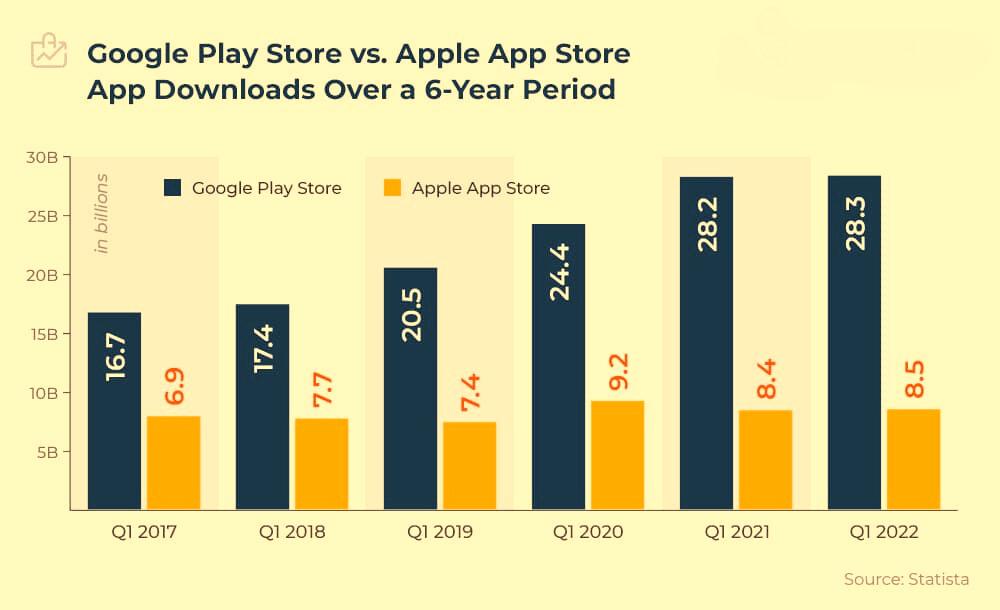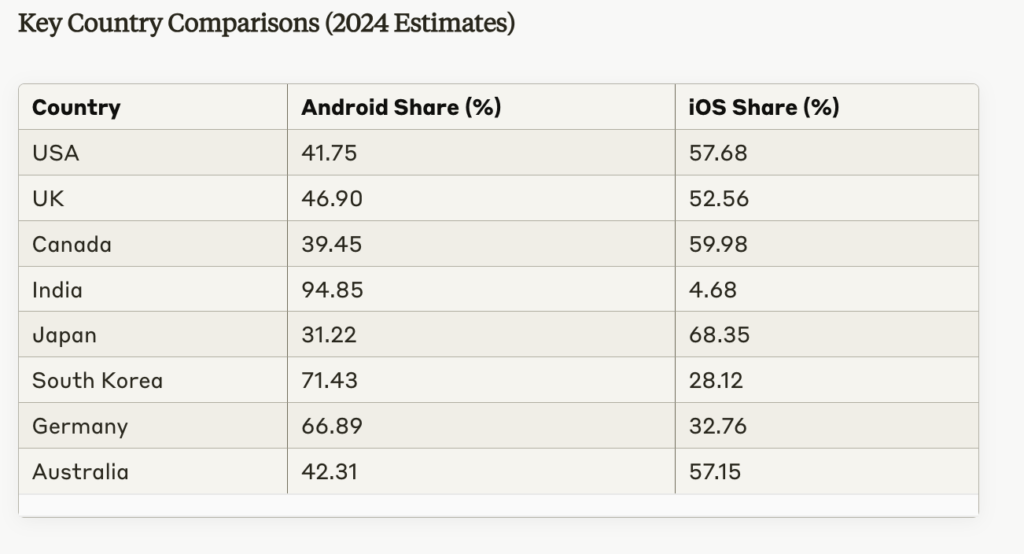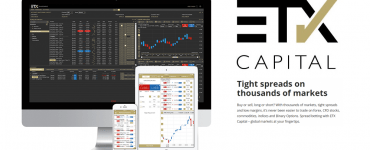Brief overview of Android and iOS platforms
The mobile device landscape is dominated by two major operating systems: Android and iOS. Android, developed by Google, is an open-source platform various device manufacturers use, offering a wide range of devices at different price points. iOS, created by Apple, is a closed ecosystem exclusively for Apple devices, known for its seamless integration and high-end user experience.
Importance of understanding user behaviour differences inAndroid vs iOS
Understanding the behavioral differences between Android and iOS users is crucial for app developers, marketers, and businesses. These insights can inform product development, marketing strategies, and user experience design, ultimately leading to more effective targeting and higher user satisfaction across both platforms.
The significance of these differences is underscored by the sheer scale and economic impact of the mobile app ecosystem:

- Market Size: As of 2023, the global mobile app market size was valued at approximately $206.85 billion, with projections to reach $567.18 billion by 2030 (Grand View Research, 2023).
- App Store Statistics:
- Google Play Store: Over 3.5 million apps available (Statista, 2023)
- Apple App Store: Approximately 1.96 million apps available (Statista, 2023)
- Downloads:
- In 2022, consumers downloaded 255 billion mobile apps, with Android leading in the number of downloads (App Annie, 2023)
- Google Play saw 111.3 billion app downloads in 2022, while the Apple App Store had 34 billion downloads (Sensor Tower, 2023)
- Revenue:
- Despite fewer downloads, the Apple App Store generated $85.1 billion in revenue in 2022, compared to Google Play’s $47.3 billion (Sensor Tower, 2023)
- iOS users tend to spend more on apps, with the average revenue per download being significantly higher than on Android
- User Engagement:
- Mobile users spend an average of 4.8 hours per day on their mobile devices (App Annie, 2022)
- iOS users typically spend 18% more time in apps than Android users (Adjust, 2023)

These statistics highlight the massive scale of both platforms and the significant differences in user behaviour. For instance, while Android leads in total downloads, iOS generates more revenue, indicating different spending patterns among users.
Understanding these nuances allows businesses to:
- Tailor app development priorities for each platform
- Optimize marketing strategies to reach the right users
- Design user experiences that align with platform-specific expectations
- Make informed decisions about resource allocation between platforms
- Predict and capitalize on emerging trends in mobile user behaviour
By leveraging these insights, companies can maximize their impact in the mobile space, ensuring their products resonate with users on both platforms and drive better business outcomes.
2. Demographic Profiles for Android vs iOS
2.1 Age distribution
Android and iOS users show distinct age distribution patterns:
- Android users tend to have a more evenly distributed age range, with a slight skew towards younger users.
- iOS users are often concentrated in the 18-34 age bracket, with a higher proportion of users in their late 20s and early 30s.
2.2 Income levels
Income levels play a significant role in platform choice:
- Android devices cater to a wider range of income levels due to the variety of devices available at different price points.
- iOS users generally have higher average income levels, reflecting the premium positioning of Apple products.
2.3 Education backgrounds
Education levels also show some differences between the two user groups:
- Android users represent a broader spectrum of educational backgrounds.
- iOS users tend to have a higher percentage of college graduates and post-graduates.
2.4 Geographic distribution
The geographic distribution of Android and iOS users varies globally:
- Android dominates in developing markets and rural areas, benefiting from its wider range of affordable devices.
- iOS has a stronger presence in urban areas and developed countries, particularly in North America and Western Europe.

Regional Dynamics of Mobile Operating Systems (2024 Update)
Global Overview
As we move through 2024, the mobile operating system landscape continues to evolve, with Android maintaining its global dominance while iOS strengthens its position in developed markets. This section explores the current state of mobile OS market share across various regions and countries.
Global Market Share (2024 Estimates)
| Operating System | Market Share (%) |
|---|---|
| Android | 71.32 |
| iOS | 28.06 |
| Others | 0.62 |
Regional Breakdown
The distribution of mobile operating systems varies significantly across different regions, with economic factors, local preferences, and market maturity playing crucial roles.
Key Country Comparisons (2024 Estimates)

Source: StatCounter global stats (2024 projection)
Android vs iOS Analysis of Trends
- Developed Markets: iOS continues to gain ground in high-income countries. The USA, UK, Canada, and Australia show a preference for iOS devices, likely due to higher disposable incomes and strong brand loyalty to Apple.
- Emerging Markets: Android remains dominant in developing countries like India, where its market share exceeds 90%. This is primarily due to the availability of a wide range of affordable Android devices.
- Asian Dynamics: Interesting contrasts are seen in Asia. While Japan shows a strong preference for iOS, South Korea (home to Samsung) leans heavily towards Android. This highlights the impact of local manufacturers and cultural preferences.
- European Variation: European countries show diverse preferences. The UK leans towards iOS, while Germany shows a stronger preference for Android, reflecting different market dynamics and consumer behaviours within Europe.
- Global vs. Local Trends: While Android leads globally, iOS outperforms in several key markets, especially in countries with higher GDP per capita.
Factors Influencing Market Share
- Economic Considerations: The cost factor remains significant. Many users opt for Android devices due to their wider price range, despite a potential preference for Apple products.
- Ecosystem Lock-in: In markets where iOS has a strong foothold, the Apple ecosystem (including services like iMessage and FaceTime) plays a crucial role in retaining users.
- Device Diversity: Android’s wide range of devices from various manufacturers caters to diverse user needs and preferences, contributing to its global dominance.
- Local Manufacturing: Countries with strong local smartphone manufacturers (e.g., South Korea with Samsung) tend to have higher Android shares.
- 5G Adoption: The rollout of 5G networks is influencing consumer choices, with both Android and iOS devices competing to offer the best 5G experiences.
3. Device Usage Patterns
3.1 App download and usage frequency
App engagement differs between the two platforms:
- Android users tend to download more apps but have lower engagement rates per app.
- iOS users download fewer apps but show higher engagement and retention rates.
3.2 Time spent on devices
Daily screen time varies between Android and iOS users:
- Android users generally spend more time on their devices, partly due to the larger screen sizes of many Android phones.
- iOS users, while spending less total time, tend to have more frequent, shorter sessions throughout the day.
3.3 Preferred device features
Users of each platform prioritize different features:
- Android users often value customization options, expandable storage, and diverse hardware choices.
- iOS users typically prioritize seamless ecosystem integration, privacy features, and consistent software updates.
4. Purchasing Behavior in Android vs iOS
4.1 In-app purchases
In-app purchase patterns show significant differences:
- iOS users are more likely to make in-app purchases and spend more per transaction.
- Android users make fewer in-app purchases but represent a larger total market due to the platform’s larger user base.
4.2 Mobile commerce trends
E-commerce behaviors vary between the two groups:
- iOS users tend to make more purchases via mobile devices and have higher average order values.
- Android users engage more in mobile window shopping but are more likely to complete purchases on desktop devices.
4.3 Brand loyalty and ecosystem investment
The level of investment in each ecosystem impacts user behaviour:
- iOS users often display higher brand loyalty and are more invested in the Apple ecosystem, making them less likely to switch platforms.
- Android users show more variability in brand loyalty, often switching between different Android device manufacturers.
5. App Preferences
5.1 Types of apps used most frequently
Android and iOS users show different preferences in app categories:
- Android users tend to favor utility apps, customization tools, and alternative app stores.
- iOS users generally prefer productivity apps, health and fitness trackers, and creative tools.
Both groups show high engagement with social media and messaging apps, but platform-specific differences exist:
- Android users are more likely to use WhatsApp and Facebook Messenger.
- iOS users show higher engagement with iMessage and FaceTime.
5.2 Gaming habits
Gaming behaviours differ between the two platforms:
- Android users tend to play more casual and free-to-play games.
- iOS users are more likely to engage with premium games and spend more on in-game purchases.
The types of games popular on each platform also vary:
- Android sees more downloads of strategy and simulation games.
- iOS users show a preference for puzzle and adventure games.
5.3 Social Media Engagement
While social media is popular on both platforms, usage patterns differ:
- Android users spend more time on YouTube and Twitter.
- iOS users show higher engagement rates on Instagram and Snapchat.
Both groups use Facebook extensively, but iOS users tend to access it more frequently via mobile devices.
6. Privacy and Security Attitudes
6.1 Concerns about data protection
Privacy concerns and behaviours vary between Android and iOS users:
- iOS users generally express higher concerns about data privacy and are more likely to adjust privacy settings.
- Android users show more variability in privacy concerns, often depending on the device manufacturer and Android version.
6.2 Adoption of security features
The use of security features differs between the platforms:
- iOS users are more likely to use biometric authentication methods like Face ID or Touch ID.
- Android users have a wider range of security options but show lower overall adoption rates of advanced security features.
6.3 Willingness to share personal information
Attitudes towards sharing personal data show some differences:
- iOS users are generally more cautious about sharing personal information with apps and services.
- Android users show more willingness to share data, especially if it enhances app functionality or personalization.
7. Customization and Personalization in iOS vs Android
7.1 UI/UX Preferences
The approach to user interface and experience varies significantly:
- Android users value the ability to customize their home screens, use widgets, and modify system-level settings.
- iOS users appreciate the consistent and streamlined interface across devices, with a focus on ease of use.
7.2 Use of widgets and launchers
The use of customization tools shows a stark contrast:
- Android users frequently use custom launchers, icon packs, and widgets to personalize their device experience.
- iOS users have limited customization options but show high engagement with the widget feature introduced in recent iOS versions.
7.3 Frequency of OS updates
Update behaviours differ between the two ecosystems:
- iOS users typically update their operating systems quickly when new versions are released, due to Apple’s centralized update system.
- Android users experience more variability in update availability and frequency, often depending on the device manufacturer and model.
8. Brand Perception and Loyalty
8.1 Reasons for platform choice
Users choose Android or iOS for different reasons:
- Android users often cite affordability, device variety, and customization options as key factors.
- iOS users frequently mention brand reputation, ecosystem integration, and perceived quality as primary reasons.
8.2 Likelihood of switching platforms
The propensity to switch between platforms varies:
- Android users show a higher likelihood of considering a switch to iOS, especially as they move to higher income brackets.
- iOS users demonstrate stronger brand loyalty and are less likely to switch to Android, often due to ecosystem lock-in.
Factors influencing platform switching include:
- For potential Android to iOS switchers: perceived premium status, security features, and seamless ecosystem.
- For potential iOS to Android switchers: desire for more customization, wider device choices, and sometimes cost considerations.
8.3 Brand Advocacy
The level of brand advocacy differs between the two user groups:
- iOS users tend to be more vocal advocates for their platform, often recommending Apple products to friends and family.
- Android users show more varied levels of brand advocacy, often tied to specific device manufacturers rather than the Android platform as a whole.
Social media engagement related to brand advocacy also differs:
- iOS users are more likely to engage with and share Apple-related content on social media.
- Android users’ advocacy is often more fragmented, focusing on specific device features or Android customizations.
9. Technological Adaptability for Android vs iOS
9.1 Early adoption of new features
The rate at which users adopt new technological features varies between platforms:
- iOS users tend to be quicker adopters of new features within the Apple ecosystem, partly due to the more streamlined update process.
- Android users have a more varied adoption rate, with tech enthusiasts quickly embracing new features while others may lag behind due to device fragmentation.
9.2 Attitude towards emerging technologies
User attitudes towards emerging technologies show some differences:
- Android users often show more interest in experimental features and cutting-edge hardware innovations.
- iOS users typically express more interest in refined implementations of new technologies, prioritizing stability and integration.
Examples of emerging technology adoption:
- Android users are more likely to experiment with features like foldable screens, under-display cameras, and alternative mobile payment systems.
- iOS users show higher adoption rates for features like augmented reality applications, mobile-based health monitoring, and integrated smart home technologies.
10. Conclusion
10.1 Summary of key behavioral differences
The comparison between Android Vs iOS users reveals several key behavioral differences:
- Demographics: Android users span a broader range of age groups and income levels, while iOS users tend to be younger and have higher average incomes.
- App Usage: iOS users generally show higher engagement rates and are more willing to pay for apps and make in-app purchases. Android users download more apps but have lower per-app engagement.
- Privacy and Security: iOS users typically show more concern about privacy and are more likely to use advanced security features. Android users have more varied attitudes towards privacy and security.
- Customization: Android users value the ability to customize their devices extensively, while iOS users appreciate the consistent, streamlined interface across devices.
- Brand Loyalty: iOS users generally show stronger brand loyalty and are less likely to switch platforms compared to Android users.
- Technological Adoption: Both groups show interest in new technologies, with Android users more likely to experiment with cutting-edge features and iOS users preferring refined implementations.
10.2 Implications for developers and marketers
Understanding these behavioral differences has significant implications for developers and marketers:
- App Development:
- Developers should prioritize different features and monetization strategies for each platform. For iOS, focus on polished UIs and in-app purchase models. For Android, consider freemium models and wider device compatibility.
- Marketing Strategies:
- Tailor marketing messages to resonate with each user base. Emphasize customization and affordability for Android, and focus on ecosystem benefits and premium experiences for iOS.
- User Experience Design:
- Design interfaces that align with platform-specific expectations. Offer more customization options for Android, and ensure a sleek, consistent experience for iOS.
- Privacy and Security:
- Prioritize clear privacy policies and robust security features, especially for iOS apps. For Android, educate users about available security options.
- Update and Support:
- Plan for more frequent updates and longer support cycles for iOS apps. For Android, consider a modular approach to support a wider range of devices and OS versions.
- Emerging Technologies:
- When introducing new technologies, consider a more experimental approach for Android users and a more refined, integrated approach for iOS users.
By recognizing and adapting to these behavioral differences, developers and marketers can create more targeted, effective strategies for each platform, ultimately leading to better user satisfaction and business outcomes in the mobile ecosystem.






 United States
United States United Kingdom
United Kingdom India
India Canada
Canada Singapore
Singapore















![10 Benefits of the Internet of Things You Should Know [2025]](https://cdn-dkjjl.nitrocdn.com/LPyQRQuQQgeCWnCNuygqLTfDwWSgOhAI/assets/images/optimized/rev-dfb6f24/www.appstory.org/wp-content/uploads/2025/03/ATS-10-Benefits-of-the-Internet-of-Things-You-Should-Know-2025@2x-80x60.png)




















